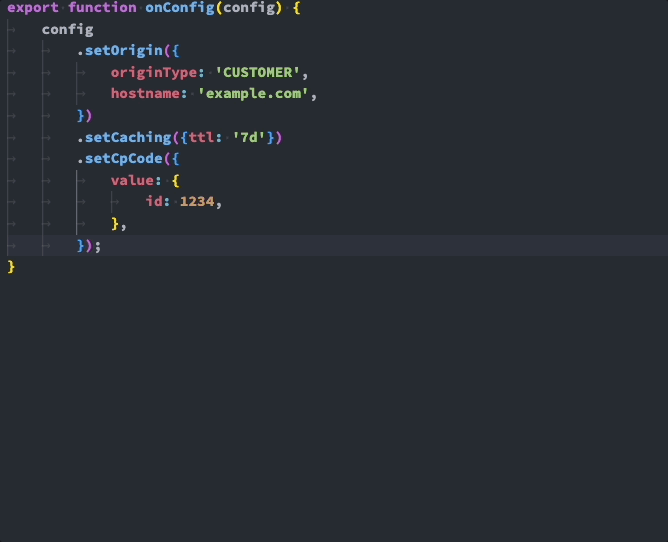Important
The goal of this tech preview is to gather feedback to further refine the existing capabilities and to identify areas for future development. This tech preview product may contain usability limitations and possibly some bugs. Do not use this tool to create or update properties enabled on the Akamai production network.
Table of Contents
- Node.js >= 21.6.0
- npm >= 10.2.4
- Akamai EdgeGrid Credentials
| Permission | Access Level | Usage |
|---|---|---|
| Contracts-API_Contracts | READ-ONLY | Listing available contracts within the init behaviour |
| CPcode and Reporting group (cprg) | READ-WRITE | Listing and creating cpcodes |
| Edge Hostnames API (hapi) | READ-WRITE | Creating Edge Hostnames when creating a new property |
| EdgeWorkers | READ-WRITE | Creating and updating EdgeWorkers |
| Property Manager (PAPI) | READ-WRITE | Creating and updating properties |
Akamai Techdocs contains instructions on how to create an API client with custom permissions.
npm install --save-dev akj-tech-previewThe Programmable CDN tech preview installs the akj command.
Usage: akj [options] [command]
Generates PAPI JSON from an onConfig() function
Options:
-V, --version output the version number
-e, --edgerc <path> Path to your .edgerc authorization file. (default: "/home/node/.edgerc")
-s, --section <name> Section of your .edgerc to use. (default: "default")
-a, --accountSwitchKey <key> Account switch key.
-D, --debug Show debug output
-h, --help display help for command
Commands:
activate [options] [base] Generates PAPI JSON from an onConfig() function and upload it to Property Manager
init [base] Configure a Property to use. Either by creating a new property or finding an existing one.
help [command] display help for command
The akj command comprises two subcommands:
init- A guided setup for the files and structure necessary to use the tool.activate- Run JavaScript code to modify a Property and EdgeWorker
Run the guided installation.
npx akj init Important
The Akamai Programmable CDN tool requires the user to accept the Terms & Conditions before being allowed to use the tool.
The tool requires the following to operate and will prompt for:
- An email address to receive notices from the Akamai services indicating resources have been created or activated.
- A contract to associate with any created resources
- A group to associate with any created resources
- A property to work with (either an existing property or the tool will assist in creating one)
- An EdgeWorker (either an existing EdgeWorker or the tool with assist in creating one)
- A CPCode to associate with the created files.
When the guided initialization is complete, 4 new files will be created:
property.json- Information needed to call the Property Manager APIsrc/bundle.json- The EdgeWorker manifest file.src/main.js- The EdgeWorker JavaScript source file.src/config.js- The JavaScript configuration file that will be used to create the Akamai Property.
The config.js file is required to export an onConfig function. This function takes a single argument config of type Property.
export function onConfig(config) {
config
.setOrigin({
originType: 'CUSTOMER',
hostname: 'www.example.com',
})
.setCaching({ttl: '7d'})
.setCpCode({
value: {
id: 1234,
},
});
}The config object provides a builder pattern interface to creating a property. In the previous code example, methods are chained together to set an Origin behaviour, a caching behaviour and the CP Code behaviour for the Property.
Rules can be used to group behaviours together or apply match criteria. In the following example, a Rule containing matchers is created. The any criteria specifies that the EdgeWorker behaviour will be added if either the Query String Parameter or the Request Cookie are present.
export function onConfig(config) {
config
.setOrigin({
originType: 'CUSTOMER',
hostname: 'www.example.com',
})
.setCaching({ttl: '7d'})
.setCpCode({
value: {
id: 1234,
},
});
// Setup a rule matching either a Querystring or cookie is present
config
.newBlankRule('Conditional EdgeWorker', 'Conditionally apply the Specified EdgeWorker.')
.any(rule => {
rule.onQueryStringParameter({
parameterName: 'ew-enabled',
values: ['true', 'on', '1'],
});
rule.onRequestCookie({
cookieName: 'ew-enabled',
matchOperator: 'EXISTS',
});
})
.setEdgeWorker({
edgeWorkerId: '1234',
});
}When writing the onConfig files, configuring type checking allows for code completion and inline documentation.
The akj activate command will use modified files to apply the config.js file to a property and the bundle.json and main.js files to an EdgeWorker.
Usage: akj activate [options] [base]
Generates PAPI JSON from an onConfig() function and upload it to Property Manager
Arguments:
base Root of your PCDN property.
Options:
-p, --property <path> Optional path to the JSON file that contains property information
-d, --dry-run Stop execution after producing PAPI JSON. (default: false)
-w, --stop-on-warning Stop activating the property if there are warnings. (default: false)
-j, --print-papi-json Print the PAPI Json to the console during property operations. (default: false)
-o, --save-only Save the property version without activation. (default: false)
-h, --help display help for commandTo activate the Property and EdgeWorker, run the following command from the directory containing your property.json and src folder:
npx akj activateWhen creating a new property, there are a few required behaviours that need to be specified. The minimal onConfig function is specified in the minimalProperty example.
onConfig can be used to setup user defined variables. When using the Property Manager User Interface, variables are required to be defined in the Property Variables section. When using the config object, variables can be defined implicitly using the setVariable function.
Using setSetVariable will defined the specific variable name for you, and allow its value to be set without needing to define it separately.
See the example here.
Brief description of the example we usually do with a control.json file that is parsed and applies rules in a loop.
When creating a new property, the Akamai Control Center can populate a set of default behaviours and criteria. The property will setup caching rules, enable MPulse RUM, log delivery, SureRoute and a variety of features.
See the example here.



